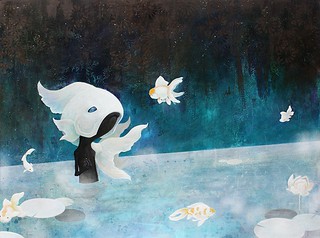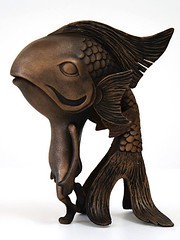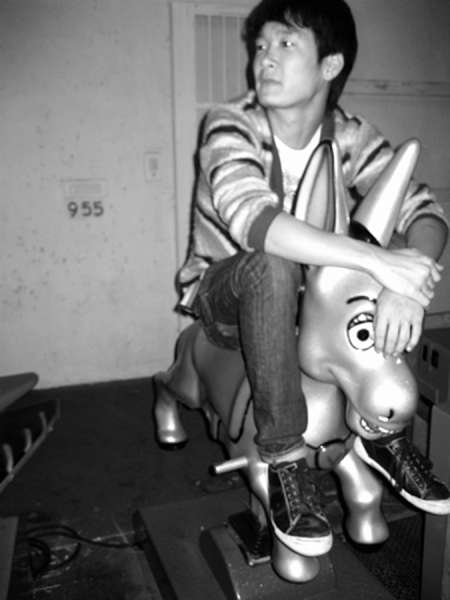Yoskay Yamamoto
Website: www.yoskay.com
Painter, Sculptor: Los Angeles
Standing on the edge of the sidewalk, Yoskay Yamamoto faced the traffic, stretched out his arm, and waved his hand up and down in the Manhattan night.
“Is there any secret to getting a cab in New York City?” he asked.
Feeling the November breeze, I put my hands in my pockets and took a step back, watching him for a moment.
“You’re already doing it”, I assured.
He laughed. But in just a few moments a yellow car pulled up alongside us and Yoskay was headed back downtown, where he’d be part of a group show for the weekend.
What immediately strikes me about Yoskay? It’s a certain kind of energy. Really friendly, really warm, really genuine. It makes me feel like he’d be able to get around anywhere – his original home of Japan, his current home in Los Angeles, here in New York City.
But in another way, that’s just it. Yoskay has lived in many places. As he’ll tell you, as much as he does get along wherever he lives, it sometimes gives him a certain “fish out of water” feeling.
“Even if I go back to Japan, I’ve spent so many years in the states that there’s a gap between even me and my family – and my family are the closest people I know in Japan. And even here – I’ve been here in the states for 12 years now, but I still feel like I don’t fit in completely.”
 Ever So Gently Ever So Gently |
There’s a real complexity of emotions there. And it appears, sometimes subtly, in Yoskay’s art. Go to a gallery and see his work up close. Look for the intricate backgrounds, the patterns, the textures. The detail will amaze you.
But there’s something even deeper in his work. There’s always motion. Or perhaps better yet, there’s always a moment. And looking closely at his work, I grow concerned – these moments aren’t going to last very long.
 Standing Still Standing Still |
Look at Standing Still. Blink once and those waves will look completely different. And just look at the faces of his portraits. Do they sense it, too?
“There are some paintings that took me forever and ever. It’s sometimes challenging to me to figure out how to project what I want to do, but I really enjoy that challenge because with a bigger challenge the outcome can be greater."
"I just enjoy that process of something being blank, or having nothing in the beginning, and I love those moments when I surprise myself, like: ‘how did this happen?’ or ‘where did this come from?’ Sometimes it doesn’t turn out exactly how you think, but sometimes it’s better that way.”
The finished products are incredible. So there’s a double-edged sword to being a fish out of water. Difficulties, yes. But a positive can also be taken from it. What inspires Yoskay has a definite energy, and a Japan–Los Angeles–New York connection: skateboarding, graphic design, ancient Kado art, textile design, manga. And a combination of modern and ancient culture, we agreed, is always an attractive thing in the art world.
“Yeah! Even like mixing two different genres together – there’s a band called The Roots that’s like a fusion of jazz and hip-hop, and together it makes something very unique. So I don’t know, I just enjoy that. Combining two, sometimes three styles and making something unique and interesting.”
So it’s natural how the influences appear in his work. Ancient and modern, together. Somehow there’s a balance of organic shapes and geometric patterns. He looks for them anywhere; stencils, plastic embroidery templates, metal screens, even on objects many people might overlook.
“My friends were throwing away these speakers and they’re like, ‘Yoskay, you want these?’ and I was like, ‘No, I don’t really need a speaker.’ But then I looked at the back of them and there were all these little dots, and I was like, ‘You know what? I’ll actually take those.’"
 Do You Mind if I Stay for a Bit? Do You Mind if I Stay for a Bit? |
But take your eye from the background of the paintings – the patterns, colors, textures – and note the portraits themselves. Some are male, some female; some more mythical than human. And one specific character returns again and again. He literally embodies the fish out of water sentiment. Yoskay calls this character Koibito. And its origin is just as unique as the character itself.
“I used to have a pet fish named Tuna and he passed away because of my poor treatment and laziness. So after he died I painted some fish, and the Koibito character came about. People somehow really related to it, or they just found it so amusing or interesting that it became one of the characters that people really know about in my work.”
So much so that Koibito is now a limited-edition toy. And a big success at the Comicon, where enthusiasts have lined up to get raffle tickets, hoping to win, for example, one of only thirty bronze-coated Koibito.
 Bronze Koibito Bronze Koibito |
“I saw this one girl looking at the winning number, and when she found out she won she got super-excited and happy about it. Witnessing something like that is completely amazing. That was one of the highlights of my career. That kind of stuff always inspires me to work even a little bit harder. I’m very, very grateful.”
Yoskay still creates at least one Koibito painting with each new body of work, knowing that they’ll be highly desired. But with good reason, he’s also very cautious.
“I love the character, you know? But at the same time I don’t want to create too many Koibito paintings. He’s really precious to me. I’m trying to be protective about it. So that’s why even with the toy I didn’t want to make, like, 20 colors. I don’t want to be stuck as the artist who only does Koibito."
"I don’t think we’d get to evolve much. Growing as an artist – it’s our responsibility.”
I think of where Yoskay might be years from now. Painting and sculpting in Los Angeles? Stenciling on fabric in New York? Or perhaps Tokyo, with his work in public spaces? Somehow I feel it will be anything he can think of. And it excites me to picture how he and his archive will grow.
“I like the progression. My first show was in 2005. Nobody was approaching me to show my work because nobody knew me, so I would go around with my portfolio and a coffee shop would be nice enough to showcase my work. From coffee shop shows to boutique shows, then to group shows at galleries, and now I get to do a solo show every year. I like looking back sometimes because I kept all the flyers. Even when I would do a show at the coffee shops I would make my own flyers. It’s nice to have that archive of your progress.”
{december 2009}
(images c/o Yoskay Yamamoto)
All stories are copyright of Gregory Koutrouby and A Thousand Stories unless otherwise noted.
